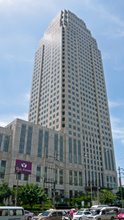
Architects want simpler assessment approvals for 'friendlier' buildings
Environmental friendliness, energy saving and "green" principles are rapidly becoming major trends in Thailand's property market, involving both property developers and producers of construction materials.
The companies are dancing to a tune played by consumers, who are these days keenly attuned to environmental issues and prefer buildings designed to minimise energy use.
In a significant move, the Association of Siamese Architects under Royal Patronage (ASA) has proposed to the Office of Natural Resources and Environmental Policy and Planning (Onep) that building projects developed in accordance with environmental and energy-saving principles should face a simpler form of environmental-impact assessment (EIA).
The proposal comes at a time when Onep itself has been considering the EIA procedure and how it can speed up approvals.
A survey by The Nation last week found both property developers and producers of construction materials were eager to meet the green demands of modern home-buyers who want to buy environmentally friendly homes that save energy bills. Home-buyers believe this will save them money in the long term.
The Siam Cement Group (SCG) is one producer of construction materials that has spent more than Bt1 billion on researching and developing green materials for all of kinds of construction, in the belief that doing so not only meets customer demand, but is also environmentally responsible.
One subsidiary, Siam White Cement, has developed white plaster and marble-surface textures for walls and floors that do not need painting. Another, Siam CPAC Block, has developed cool-plus blocks that are claimed to reduce internal heat in a building by seven to 10 per cent, as well as specialised blocks for roof gardens.
SCG Cement marketing director Syamrath Suthanukul said the group had a target of launching an average of ten innovative products per year, most of them green products developed to meet customer demand.
Siam City Cement has also announced a "Green Innovation" policy, under which it will develop new products and production processes to serve the growing demand for environmental friendliness.
Property developers are not only incorporating green principles into their buildings, but they're also providing greater contact with nature on the ground.
Supalai CEO Prateep Tangmatitham said architects had to begin their job by considering prevailing wind directions and the path of the sun from sunrise to sunset. Then, they not only had to select raw materials appropriate to the building's design, but also according to their ability to save energy.
Residential projects also have to incorporate larger green areas, in the form of parks and gardens, to suit modern lifestyles in which customers want to feel closer to nature, he said.
A new concept in energy self-sufficient housing is expected to arrive on the Thai market in the fourth quarter of this year.
LPN Development is planning a residential development whose main concept is care for the environment and energy saving. Managing director Opas Sripayak said his company believed the concept would generate greater long-term benefits for its customers.
"When home-owners live in a green building they will save on their electricity bills and living in a green area will give them a better quality of life," he said.
He said there would be clear environmental benefits if Onep accepted the ASA's proposal, because property developers would be encouraged to design and build green buildings.
Meanwhile, property agency Jones Lang LaSalle has taken the lead in a US project that may pave the way for similar energy sustainability projects around the world.
The agency is programme manager of a "highly collaborative team" that plans to take New York's iconic Empire State Building and reduce its energy use and greenhouse gas emissions by up to 38 per cent.
Once completed, the building is expected to achieve an Energy Star score of 90, placing it in the top 10 per cent of efficiency for class-A buildings - a major feat for a pre-war property. As well, it will seek certification as a Leadership in Energy and Environmental Design Green Building.
The New York project will make the first comprehensive approach to modelling steps for the reduction of energy consumption, in the hope that the process will be followed in buildings around the world.
The programme is aimed at providing an economically sound path for owners of existing buildings to pursue responsible energy management profitably.
Source: The Nation 3 June 2009


No comments:
Post a Comment